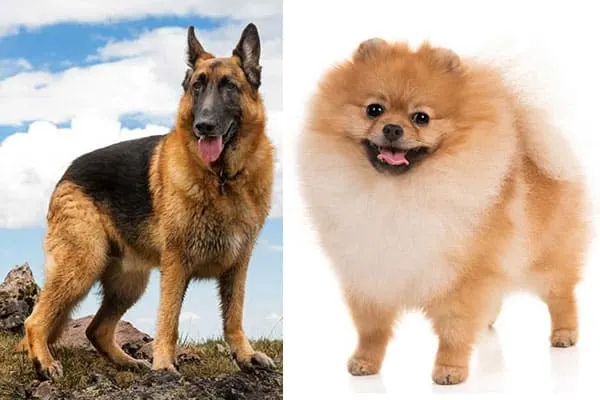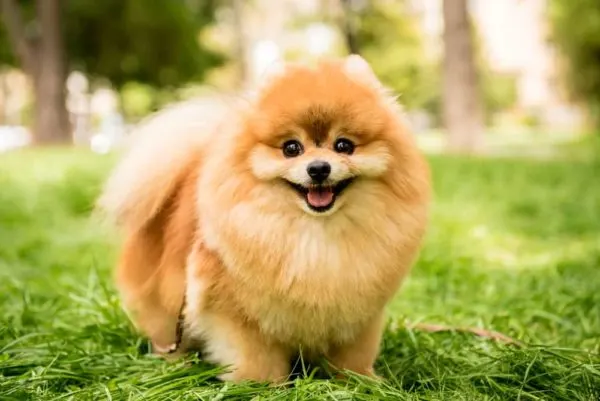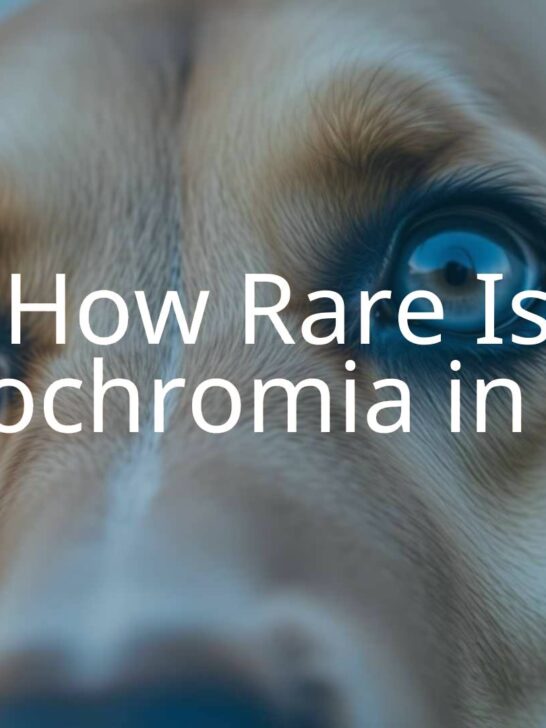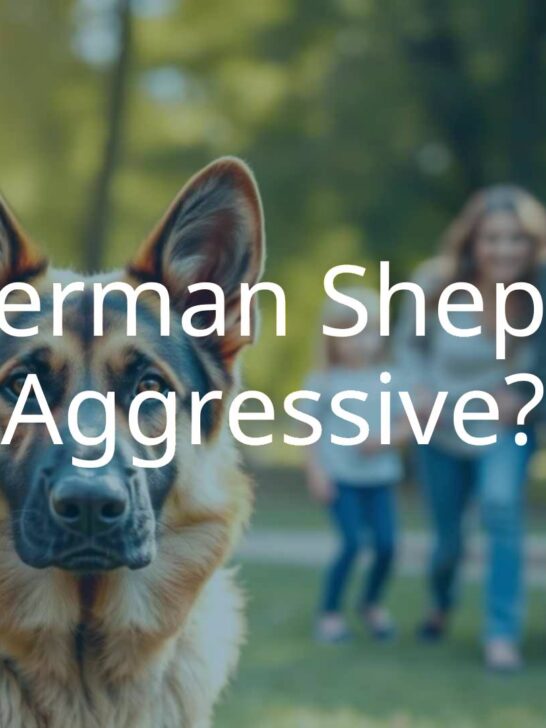German Shepherd Pomeranian Mix: How Opposites Perfectly Combine!
When people recite the popular proverb “opposites attract,” they probably are not referring to dog breeds.
However, you could say the Pomeranian German Shepherd mix is a harmonious blend of two breeds who are physically near opposites.
A natural question you might ask is what traits do each of the parent breeds contribute to the German Shepherd Pomeranian mix, and how do they create a desirable pet?
The German Shepherd Pomeranian mix, sometimes called a German Pomeranian, is a compact, medium-sized designer dog with long hair and a curled tail.
He has a bright expression with prominent dark eyes and a ruff around the neck, possibly extending to the shoulders.
His parent breeds have a working background, making the German Pomeranian a loyal, affectionate, active, and steady companion.

Where does the German Shepherd Pomeranian Mix come from?
German Shepherds draw their ancestry from generic herding dogs from three regions in Germany.
In 1899 Max von Stephanitz selected the first dog to go into the GSD registry, Hektor Linksrhein (later, Horand von Grafrath), from the Thuringian region.
The German Shepherd was found quick to use as a general working dog with good guarding instincts. The AKC recognized the GSD breed in 1913.
The Pomeranian descends from a large working German Spitz type that rose to prominence in the 1800s.
She obtained her name from a term meaning “around the sea” about Pomerania of the Baltic Sea and surrounding regions encompassing parts of Germany and Poland.
Pomeranians were originally working dogs weighing about 30 pounds and used for sleighs and guarding property and livestock.
The English later developed the toy or dwarf Spitz that became the modern Pomeranian around the mid-1850s. The AKC recognized the Pomeranian in 1888.
Origins of the GSD-Pomeranian are murky, but the dog mix probably has its roots in the United States after the 1990s.
Possible motivations for such a mix are purely speculative but may include health reasons or the creation of a larger dog for children, a friendlier dog for families, and a more intimidating watchdog.
Physical traits your puppy may inherit are size, conformation, and color
German Shepherd
The GSD is a medium-sized to large dog. Females are noticeably smaller, and the breed standard calls for a more feminine appearance than males.
They are 22 to 24 inches tall and weigh 48 to 70 pounds in contrast to males who are 24 to 26 inches at the shoulders and up to 90 or 95 pounds.
A German Shepherd, no matter where she falls in the size range, has a distinctive presence and profile.
She is longer than she is tall at a ratio of 10:8 with a long bushy tail she carries low, large upright ears, and a sloping topline which is exaggerated in show lines.
A German Shepherd also has a rather long squarish muzzle, almond-shaped dark eyes, and a dome-shaped forehead.
German Shepherds, or Alsatians, have heavy double coats, short to medium coarse hairs overlying thick wooly fur.
The standard includes a variety of colors, most approved by the American Kennel Club and other registries.
Standard Colors
- Black and tan
- Black and red
- Black and silver
- Solid red
- Solid black
- Bicolor – Black with minor tan points
- Sable
Faulted Colors
- Blue – solid blue, blue and tan, blue bicolor
- Liver – solid liver, liver and white, liver bicolor, liver and tan
Unapproved Colors
White German Shepherds, according to the AKC, are to be immediately dismissed from the show ring. However, white Shepherds can compete in other GSD-specific contests.
White GSD clubs hold conformation shows separate from the AKC.
Panda German Shepherds originated with one family line that had a rare genetic mutation. The possibility exists that this color mutation has occurred in multiple litters in separate isolated cases.
As 35% of the dog’s coat is white, Panda Shepherds do not qualify for AKC shows and must undergo rigorous genetic screenings for you to even register them as purebred.
Pomeranian
Poms are only about seven to twelve inches tall and weigh between three and seven or eight pounds.
Typical of all Spitz members, they have a wedge-shaped head, upright ears, a dense double coat, and a tail they carry over their backs. They tend to be relatively square and compact in shape.
Pomeranians are even more varied in their colors than German Shepherds.
Accepted Colors
- Brown – Chocolate, brown, or beaver
- Lavender – Similar to the double-dilute Isabella GSD
- Cream – Born white
- Black
- Blue – Dilute black like the GSD
- Orange – Wild sable as puppies are born sable and become a solid auburn color sometimes with cream highlights
- Sable – Red Sable or cream sable; Wolf sable with dark coloring instead of reds is a dominant color pattern
- Brindle – Includes blue brindle
- Tan points – Cholate and tan, blue and tan, or black and tan
- White
- Parti-color and piebald
- Merle – In Poms a Black and tan or black dog with a dilution gene affecting the black hairs
German Pomeranian
Your German Pomeranian will likely resemble a throwback of his artic Pomeranian ancestors. Expect a medium dog from 30 to 45 pounds and standing about 13 to 15 inches at the shoulders.
He will have medium-sized prick ears, large slightly tilted eyes, and a triangular head with a tapered muzzle and slightly domed brow.
Your GSD hybrid should be compact and well-balanced with a long-reaching stride and evidence of strength through the body.
His tail will probably be moderately long and he will at least carry it up and slightly curved if not completely over his back.
German Shepherd Pomeranian mixes can be a wide range of colors
- Black and tan
- Brown
- Red or orange
- Cream
- Fawn
- Sable
- White
- Parti-colored – White with black
- Brindle
- Blue
What should you know about grooming the German Pomeranian?
Both the German Shepherd and Pomeranian have a dense double coat and shed moderately throughout the year.
Both breeds experience extensive shedding and coat replacement at seasonal times twice annually.
German Shepherd
Rarely, a German Shepherd has long fur with no undercoat whatsoever.
Since lacking an undercoat is a heavily penalized fault in the show ring, breeders have over generations selected for a dense fleecy inner hair layer.
It keeps ultraviolet sun rays from reaching your dog’s skin and insulates her from the heat.
You should ideally have three to four different types of brushes. Except for long-haired types, German Shepherds are not prone to matting.
You can check our recommendation about the best brush for German Shepherds.
In cases of long hair combined with a thick undercoat, you need a Detangler.
Otherwise, you will use a de-shedder for the undercoat, a pin brush for leftover tufts that get trapped, and a soft-bristled tool to provide the finishing touches.
You need to brush your GSD at least twice a week if not daily. Bathing will help with shedding, although too much shampooing may dry out or irritate your Shepherd’s sensitive skin.
If bathing more than once every few months, you should consider alternating with shampoo-less soakings.
Pomeranian
A Pomeranian has a long plush outer coat with a soft, dense undercoat. Poms are prone to matting, and you need to brush them at least three times a week.
Of course, daily brushing is ideal as well as baths every three to four weeks.
A steel brush or comb to remove the undercoat and loose top hairs in one fell swoop.
A Pomeranian’s coat insulates her from moisture and extremely cold weather. It gives her limited protection from hot weather as Poms were originally Arctic dogs.
Many Pomeranian owners choose not to deal with the Pom’s heavy coat and traditionally clip it close. A lion cut leaves the body short and a ruff about the neck and a tuft at the end of the tail.
German Pomeranians
Your German Shepherd Pomeranian mix will need you to brush her at least three times a week, but ideally every day. Your hybrid will likely have medium or long fur with a thick undercoat.
Both medium and long-haired dogs will have longer fringes of hair on their legs, tails, and ears. Use the same brushing tools you would for a GSD and bathe every couple of months.
Some people may be tempted to shave their GSD Pom mix, but the double coat does protect against cold and hot weather.
A German Pom’s coat will probably not be as effective against the heat as a purebred German Shepherd’s.
Make sure to check your dog’s ears at least once a week for any unusual odor, redness, or discharge. Clean excess debris.
You should clip your pet’s nails every six to eight weeks. Finally, talk to your veterinarian about an oral hygiene regimen.
How much exercise does your Pom Shepherd mix require?
If you have had any exposure to German Shepherds, you are no doubt familiar with their high energy levels and exercise requirements.
You only have to check out their proficiency in the police force and in the military to recognize their athleticism and strength.
German Shepherds need two or more hours of exercise per day, with a large part dedicated to rigorous activity and some on mental stimulation.
Breeders have had moderate success in decreasing the intensity and exercise requirements in their lines.
Do not allow the pint-size of the Pomeranian fool you. Historically Artic working dogs, a Pomeranian’s energy level resembles that of a Siberian Husky.
According to PetPom, Pomeranians need 40 to 90 minutes of exercise daily split into two to three sessions. Like Shepherds, they require vigorous activity, mental training, and socialization.
German Pomeranian
Plan on exercising your GSD-Pomeranian mix for 60 to 115 minutes a day over multiple sessions.
Puppies up to eight months of age need considerably less strenuous activity, so your focus should be on more training and socialization.
When exercising your dog, he ideally needs about half of his time to engage in hard running or other high-intensity activities such as playing fetch, tag chasing, agility, or roughhousing.
You can spend 20% of his remaining time on training obedience or other mentally stimulating tasks and the rest on cooldown or a leisurely walk.
Can your German Pomeranian be a good guard dog or an excellent watchdog?
The German Shepherd is a traditional and effective guard dog. Her background involves a longstanding culture of guarding livestock and then people and property.
Ideally, a German Shepherd gives quite a bit of warning in the form of posturing and barking before actually biting or attacking.
A German Shepherd’s attitude towards strangers is so distinctive as to be part of the breed standard. He is often polite but aloof, not lending himself readily to petting from guests.
Show lines, however, have worked to produce a more laid-back and friendlier dog geared more towards the pet market. Nevertheless, you will rarely find a Shepherd as bubbly as a Labrador or Golden Retriever.
In contrast to the GSD, Pomeranians are friendly and engaging. Inherently bold, Poms are not afraid to seek contact and attention from your guests.
Lack of shyness does not mean Pomeranians do not have a healthy dose of suspicion. Poms make loud alarmists, barking sometimes constantly at any suspicious activity or intrusions.
If unchecked, Pomeranians can become problem barkers.
You can expect your GSD-Pom will not be a quiet or stealthy animal. German Pomeranians make excellent watchdogs, announcing visitors and trespassers alike.
Mixes who inherit more German Shepherd traits will be wary of strangers and may show a tendency towards territorial aggression. Those more like Pomeranians will bark a lot but be friendly and charming.
What health concerns should you have?
Unfortunately, German Shepherds can suffer from a plethora of health disorders.
Hip dysplasia – Among the most common problems of large-breed dogs, hip dysplasia affects nearly 20% of German Shepherds.
Elbow dysplasia – Affects the elbow joint similarly to hip dysplasia albeit the elbow is more complicated.
Degenerative myelopathy – Causes degeneration of the nervous system, leading to progressive weakness and paralysis.
Hypothyroidism – The thyroid gland does not produce enough hormones.
Diabetes – A blood sugar disorder that differs in its mechanism from the disease in cats.
Pannus – A pinkish membrane grows over the cornea of the eye secondary to inflammation.
Lupus – An immune disorder that affects various organs similar to the disease in people.
Epilepsy – Seizures periodically occur with an unknown cause.
Skin allergies – German Shepherds tend to have sensitive skin.
Pancreatic sufficiency – The pancreas does not secrete enough enzymes to digest food. Dogs fail to gain weight or thrive.
While relatively healthy purebreds, Pomeranians suffer from a few common health concerns.
Hypoglycemia – Many toy breeds suffer from a rapid lowering of their blood sugar, a condition that can be life-threatening.
Luxating patella – another common affliction of toy breeds, a luxating patella means the kneecap moves out of position occasionally or frequently, causing lameness and gait abnormalities.
Heart conditions – Pomeranians can suffer from a congenital defect, patent ductus arteriosus (two major heart vessels do not separate properly, requiring surgery), or degenerating heart valves later in life.
Collapsing trachea – Yet another common toy dog problem, the tracheal rings that support the windpipe are weak, allowing the trachea to snap closed at times. The condition, which causes an intermittent honking or gasping cough, can worsen over time. Irritants and allergies exacerbate the problem.
Coat-loss syndrome – Your Pom could experience thinning and loss of his glorious coat, often secondary to male hormones. Neutered dogs do not suffer commonly from this problem.
Distichiasis – An extra set of eyelashes that are more prone to rubbing against the eyes.
Legg Calve Perthes disease – Probably related to the disrupted blood supply to the head of the femur, the femoral head subsequently degenerates, resulting in a painful condition. Pomeranians are a susceptible breed, according to the OFA.
German Pomeranian
Keep in mind any hereditary problem of a dog can pass down to its offspring, even if the puppy is a hybrid.
Dogs inherit some issues to varying degrees, and hybridization does appear to decrease the occurrence of at least a few health-related problems.
Some of the health improvements seen in mutts scientists credit to a larger gene pool. Other experts argue mixed breeds are just as prone to inherit genetic diseases as purebreds.
Further, low numbers of certain breed combinations may skew the results when checking how often something like hip dysplasia occurs in litters.
An additional complicating factor is mixed breeds can develop problems separate from their parent breeds, especially with multiple generations.
The best approach to buying a designer dog is to limit your searches to reputable breeders. Due diligence may not be possible with accidental breedings or shelter dogs who need homes.
All this being said, the problems most likely to affect your Pomeranian Shepherd mix are as follows.
- Hypothyroidism
- Epilepsy
- Legg-Perthes disease – Maybe related to your dog’s adult size.
- Hip dysplasia
- Elbow dysplasia
- Skin allergies
- Collapsing trachea
German Shepherds can live 10 to 13 years, while Pomeranians may live 11 to 16 years. Your German Pomeranian may live from 10 to 15 years.
What will your dog’s personality be like?
Temperament is much less predictable than size and other physical traits.
Especially with parent breeds with such differences in personality as the GSD and Pomeranian, it is hard to determine where the middle might be.
Nevertheless, you can draw a few conclusions about certain pet qualities based on a knowledge of how the separate breeds may behave.
German Shepherds are bold, dominant, self-assured, and brave. Unless victims of irresponsible breeding, which may allow insecurity and fear creep in, a GSD approaches work and life with a single-minded focus, perseverance, intelligence, and obedience.
In the home, German Shepherds are loyal, protective, and affectionate with a tendency to bond more strongly with particular individuals while extending their protection to all family members.
They tend to have a strong prey drive and possess moderate dog aggression. These traits make them a menace to small animals and canids they do not know.
Shepherds can be great around children with persistent training and socialization, although you should never trust them around unfamiliar kids.
Pomeranians, are surprisingly similar to the GSD in bravery and self-confidence. However, Poms are lively, humorous, and cheerful.
Leaving their working seriousness behind, they are charismatic companions who do not know a stranger.
Pomeranians can be wonderful with children, but their diminutive size makes them vulnerable to injury. They are questionable around other dogs.
While friendly with dogs their size, they carry a bravado attitude around large canids, seeming to believe they are much bigger than they are.
Their inappropriate posturing and tiny stature leave them susceptible to severe injury by medium or larger dogs.
German Pomeranian
Family Life
Your German Pomeranian will be a loyal family companion, perhaps forming strong bonds with one person but more likely being everyone’s pet.
Your mixed dog will do fine with any animal she grows up with and probably most you introduce to her slowly.
She will require supervision around dogs who are larger than her as she may exhibit a challenging attitude that would annoy the other animal.
Your GSD Pom should do excellently with children, especially when raised with them. Her larger size will ensure she is sturdier than her Pomeranian parent.
German Pomeranians may be a little protective of the family but show minimal guarding instincts. Your German Shepherd mix should be neither aggressive nor fearful with strangers.
Intelligence and training
Ranked No. 2 or No. 3 in intelligence among dog breeds, the German Shepherd has remained in high demand for his intelligence and obedience.
According to Pomeranian.org, which quotes notable sources like renowned animal psychologist Stanley Coren, Pomeranians are No. 23 in intelligence.
The Pom’s ranking places her in the good working dog group with Bernese Mountain Dogs and Belgian Malinois even despite her current status as a companion dog.
Your Shepherd Pomeranian mix will be alert, lively, intelligent, and easy to train.
A firm presence and self-assurance are crucial on your part as your dog will likely be pushy and use her cleverness for mischief as can both the German Shepherd and Pom.
A significant exception is Pomeranians can be difficult to potty train, so be aware your mix may inherit such tendencies.
Illustration
If a German Shepherd Pomeranian mix could be a classic type, the dog in this video would be it.
Resembling a Keeshond, this dog is medium in size with a face and prominent eyes that reveal both a Pomeranian and GSD expression. Watch this youtube video.
This dog is also friendly and athletic. Note the base tan color similar to a German Shepherd with a stable blanket and curled tail.





















